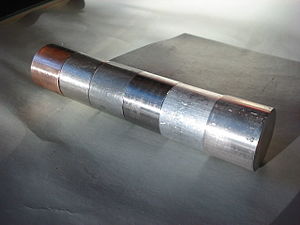
Back Legering Afrikaans मिश्रधातु ANP سبيكة Arabic Aleación AST Xəlitə Azerbaijani ارینتی AZB Legierung BAR Сплаў Byelorussian Стопак BE-X-OLD Сплав Bulgarian
This article needs additional citations for verification. (July 2024) |

An alloy is a mixture of chemical elements of which in most cases at least one is a metallic element, although it is also sometimes used for mixtures of elements; herein only metallic alloys are described. Most alloys are metallic and show good electrical conductivity, ductility, opacity, and luster, and may have properties that differ from those of the pure elements such as increased strength or hardness. In some cases, an alloy may reduce the overall cost of the material while preserving important properties. In other cases, the mixture imparts synergistic properties such as corrosion resistance or mechanical strength.
In an alloy, the atoms are joined by metallic bonding rather than by covalent bonds typically found in chemical compounds.[1] The alloy constituents are usually measured by mass percentage for practical applications, and in atomic fraction for basic science studies. Alloys are usually classified as substitutional or interstitial alloys, depending on the atomic arrangement that forms the alloy. They can be further classified as homogeneous (consisting of a single phase), or heterogeneous (consisting of two or more phases) or intermetallic. An alloy may be a solid solution of metal elements (a single phase, where all metallic grains (crystals) are of the same composition) or a mixture of metallic phases (two or more solutions, forming a microstructure of different crystals within the metal).
Examples of alloys include red gold (gold and copper), white gold (gold and silver), sterling silver (silver and copper), steel or silicon steel (iron with non-metallic carbon or silicon respectively), solder, brass, pewter, duralumin, bronze, and amalgams.
Alloys are used in a wide variety of applications, from the steel alloys, used in everything from buildings to automobiles to surgical tools, to exotic titanium alloys used in the aerospace industry, to beryllium-copper alloys for non-sparking tools.
- ^ Callister, W.D. "Materials Science and Engineering: An Introduction" 2007, 7th edition, John Wiley and Sons, Inc. New York, Section 4.3 and Chapter 9.